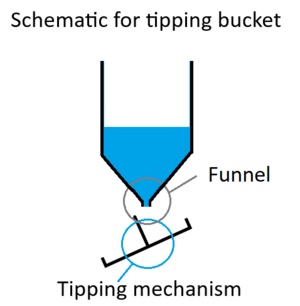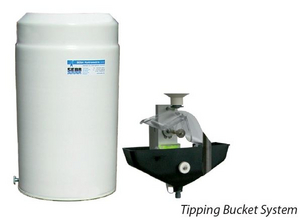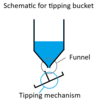
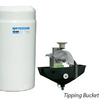
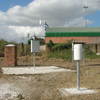
Precipitation measured the easy way
There are many rain-gauges on the market: all made to measure the precipitation in an accurate way. One of the world’s most used systems to measure the amount of rainfall is the rain-gauge that is based on the tipping bucket principle.
What is the tipping-bucket principle and how does it work?
The basic setup of a rain-gauge based on the tipping bucket principle is simple:
- a bucket to collect the water;
- a funnel to make sure that the water flows into the tipping mechanism;
- a tipping system that moves very smoothly;
- a mechanism that translates the movement of the tipping system into a contact output.
On the drawing (Schematic tipping bucket) it shows how it works. Water goes into the bucket, through the funnel, and fills up one side of the tipping mechanism. When this has reached a certain volume the tipping mechanism will ‘tip’ down which makes the other side of the tipping mechanism receive water.
By placing a magnet on the tipping mechanism, the movement of the tipping system is easily converted into a contact output by using a reed contact. The reed contact opens/ closes when the magnet in in reach. In this way every movement of the tipping mechanism is registered by the contact. A datalogger can count the opening/ closing of the contact and calculate the rainfall from this.
Typically the rain-gauge is calibrated to count (open/ close the contact) every 0,1mm or 0,2mm of rainfall, depending on the request of the user.
The receiving area of a rain-gauge is an important value: according to the guidelines of the WMO (World Meteorological Organization) the receiving area is mostly defined as 200 cm² or 400 cm². But of course there are other measurements available on the market.
By choice of the user, the datalogger can be battery operated and store all values locally, or it can be a combined datalogger/ modem combination that sends all data directly into a remote database or cloud solution.
A rain-gauge that operates on the tipping bucket principle would not need any external power to operate. The real operation (counting) is done by the magnet/ reed contact interaction so no external power is needed for that. When a data logger is being used for local or (when the datalogger has an integrated 3G or 4G modem) or remote data recording, the data logger can be battery operated and function for a long time without any need of battery replacement. Of course the system can also be connected to a solar panel in that case.
When the system is placed in an environment where temperatures can go below zero, it is optionally possible to include a heating system around the funnel to prevent freezing. In that case there is a need of external power.
Seba Hydrometrie supplies, next to the rain-gauges of the tipping bucket principle, also other rain-gauges with other measuring principles, like weighing system rain-gauges.
You are always welcome to contact us in case of any questions or specific requests. Don’t hesitate to e-mail or call us: we are available to assist you!







